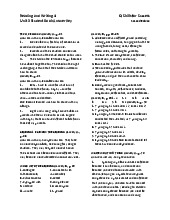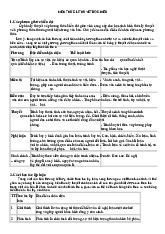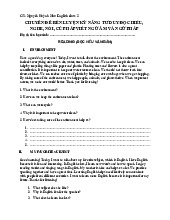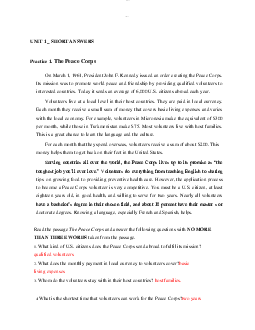



Preview text:
lOMoAR cPSD| 58507440 Reading and Writing 4 Q: Skills for Success
Unit 4 Student Book Answer Key Second Edition The Q Classroom 1. c 2. b 3. a 4. c 5. b 6. a Activity A., p. 92 7. a 8. b 9. c
10. c 11. b 12. c
Answers will vary. Possible answers:
Activity D., pp. 99–100 1.
Yes, I like to write by hand. I don’t type 1. a 2. c 3. c 4. a
fast, so I can write what I need by hand. I have Activity E., p. 100
more confidence in what I write with a pen. 1. Paragraphs 2-3 2.
Writing is a very old system. We use it 2. Paragraphs 5-7
every day, and we can use it when we don’t 3. Paragraph 4 have a computer.
4. Paragraphs 8-11 Activity F., p. 100 3.
I think these people are writing by hand 1. T
because they want to preserve a part of their 2. T culture.
3. F. Palmer states that cultures have favored Activity B., p. 92
connected script throughout time.
Answers will vary. Possible answers: 4. T 1.
So much more time consuming; easier
5. F. Children can also refine nerve connections and more practical to type
and develop good motor skills when learning 2.
Sophy – skill; calligraphy; for example; how to print.
part of being human; appreciate as skill Yuna –
important; easier to express myself; important WRITE WHAT YOU THINK
skill to learn when young Felix – best way to Activity A., p. 100
express our feelings and our personality
Answers will vary. Sample answers:
I agree with Felix that writing by hand is the best 1.
Yes, I learned how to write in two
way to express my personality./ I agree with
different ways because I learned both in school.
Marcus that writing by hand is too time 2.
It’s more important to learn to write by consuming.
hand because we use handwriting every day,
and you can always type with one or two PREVIEW THE UNIT fingers.
Activity D., p. 94 Answers will vary. 3.
Maybe people won’t have pen or paper, Sample answers.
but they will probably always have a way to
1. We get better through practice. write.
2. People would be happier if they could read other people’s handwriting. READING SKILL
3. You can change anything if you work at it long Activity A., p. 101 enough.
Speed: Print—some people can write quickly
4. Working hard is more important than working
Cursive—usually faster than print for a long time.
Legibility: Print— more legible Cursive— harder to read READING 1
Choice: Print—can also learn to type fast WORK WITH THE READING
Cursive—individualistic; people can
Activity B., pp. 98–99 choose to learn or not lOMoAR cPSD| 58507440 Reading and Writing 4 Q: Skills for Success
Unit 4 Student Book Answer Key Second Edition
Part of culture: Print—can be left to specialists
1. Haji Noor Deen was the first Chinese person
Cursive—more mature; valuable link to
to be given the award. 2. “The 99 names of past God” 3. Istanbul, Turkey READING 2
4. Harvard University, the University of PREVIEW THE READING
Cambridge, the University of California, and Activity A., p. 102 Boston University
Answers will vary. Sample answers: How he
5. ArabNews.com by Afra Naushad
started calligraphy/where he learned Activity G., p. 107
calligraphy/how long he has been involved with
Two of the world’s most beautiful styles of
it/who helped him get started/ whether this is
writing/opposites/complements/combined his profession or a hobby
result in a writing style of unique beauty WORK WITH THE READING WRITE WHAT YOU THINK
Activity B., pp. 105–106 a. Activity A., p. 108 craft
Answers will vary. Sample answers: b. essentially 1.
He wants to promote the unity of Arabic c. inspiring and Chinese cultures. d. talent 2.
Everyone should be able to learn some e. undertake
basics of calligraphy, but not necessarily to the f. exhibit extent of becoming an expert. g. imagery Activity B., p. 108 h. complement
Answers will vary. Sample answers: i. unique 1.
They can both be artistic/both are done j. determination by hand/both use words
k. recognize Activity D., p. 106 2.
There are different characters/English
1. False. He taught calligraphy at
writing is primarily functional whereas Harvard.
calligraphy is inherently artistic
(paragraph )2 OR He learned calligraphy in 3.
Learning cursive isn’t necessary so that Istanbul (paragraph 3)
time could be better spent on more important
2. True. (paragraph 4, 6) 3. True. subjects like math. (paragraph 2)
4. True. (paragraph 2, 3) VOCABULARY SKILL 5. True. (paragraph 5) Activity A., p. 109
6. False. He will seek to continue calligraphy 1. A noun, a verb (paragraph 8)
2. A boat, a skill, to make Activity B., p.
7. True. (paragraph 1) Activity E., p. 107 110 1. 1 2. 5 3. 3 4. 2 5. 4 1.
verb: make something develop or Activity F., p. 107 become more active lOMoAR cPSD| 58507440 Reading and Writing 4 Q: Skills for Success
Unit 4 Student Book Answer Key Second Edition 2.
noun: any of the long threads that
Similarities: same groups of letters form words;
carry messages between the brain and parts of
same words form sentences/ put ideas from
the body, enabling you to move, feel pain 3.
brain to more permanent form/ convey
verb: to keep stating that something is true,
information to reader; errors in both
even though other people do not agree or do Differences: not believe it
Handwriting: more information about the 4.
verb: to reach a particular age, level or
author comes out; appearance changes with condition
emotion/ paper and ink; eye on the paper/ 5.
adjective: very special or unusual 6.
easier to get away with errors Typing: screen
verb: to make yourself responsible for
and electrons; possibility of paying attention to
something and start doing it 7. verb: to give
ideas/ program often takes care of common
somebody the desire, confidence or enthusiasm
errors Activity F., pp. 115–116
to do something well 8. noun: language that 1.
In the past few years, do-it-yourself
produces pictures in the minds of people
(DIY) projects have become increasingly reading or listening
popular, but they are different from how they used to be. WRITING SKILL 2.
point by point, past and present.
Activity A., pp. 112–113
Answers will vary. Sample answer: The points
1. While both methods serve the purpose of are fairly balanced.
putting words into visible text, there are also some important differences. GRAMMAR SKILL 2. Point by point Activity A., p. 117
3. Answers will vary. Sample answer: The essay 1. Although CT
is balanced between the two subjects. 2. Similarly CP Activity B., p. 113 3. Nonetheless CT 1.
Both: same groups of letters form 4. Whereas CT
words; same words form sentences
5. Likewise CP Activity B., p. 117
Handwriting: more information about the
1. prefers to play sports
author comes out; appearance changes with
2. built a computer too emotion;
3. he likes camping better 2.
Both: put ideas from brain to more 4. go to the beach permanent form
5. appreciate having time to relax
Handwriting: paper and ink; eye on the paper 6. sleep outside
Typing: screen and electrons; possibility of Activity C., p. 118 paying attention to ideas
Answers will vary. Sample answers: 3.
Both: convey information to reader;
1. ,I enjoy cooking and eating the fish. errors in both 2. ,I find it boring.
Handwriting: easier to get away with errors;
3. , not many people become famous artists.
Typing: program often takes care of common
4. , they are also paid well.
errors Activity C., p. 113
5. , hockey is my favorite sport. lOMoAR cPSD| 58507440 Reading and Writing 4 Q: Skills for Success
Unit 4 Student Book Answer Key Second Edition
6. , I plan on working until my old age.
7. , students need ambition to learn English grammar.



